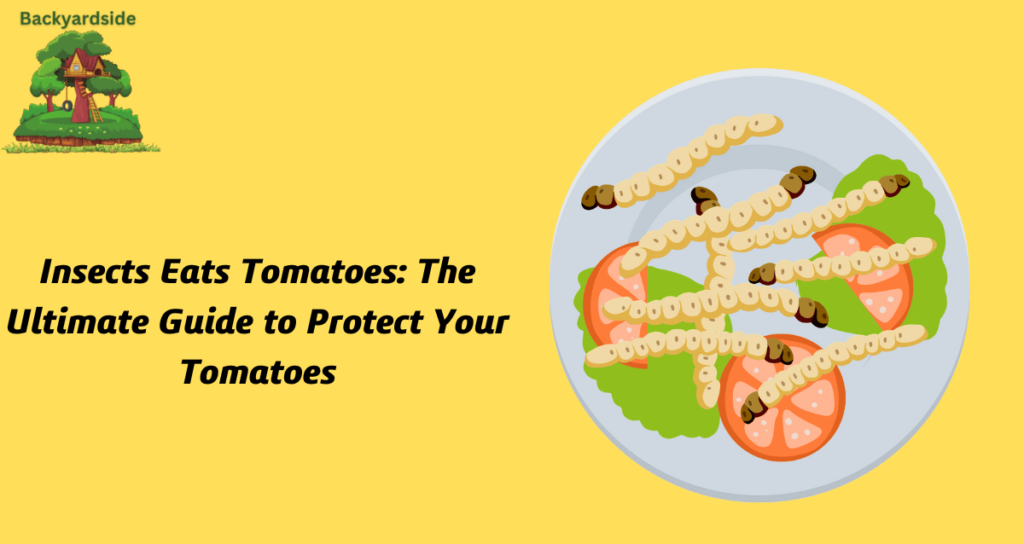Today we’re going to chat about a topic that’s a thorn in the side for many gardeners – how insects eats tomatoes. We all know the struggle – after days of tending to your tomatoes, you notice holes, yellowing leaves, or other signs that pests have been snacking on your precious plants. But don’t worry, we’ve got you covered. Let’s dive into the world of those pesky insects and learn how to shield our tomato plants from their wrath!
Insects Eats Tomatoes – The Usual Suspects

Insects feasting on your tomatoes can turn the joy of gardening into frustration. Let’s get to know these insects a bit more, shall we?
Aphids
You’ve probably seen these tiny creatures clustered beneath your tomato leaves, sucking the life out of them. A simple solution? A strong spray of water can knock them off. Additionally, planting mustard or nasturtium can divert aphids’ attention.
Blister Beetles
These sneaky insects can cause a significant amount of damage to your plants. Utilize anchored row covers to keep them at bay, and let birds do their job as natural predators.
Cutworms
These soil-dwellers can annihilate young tomato plants overnight. Be sure to check your soil before planting and place protective collars around plant stems for an added layer of protection.
Flea Beetles
Easily identified by their small size and dark color, flea beetles can be managed by employing sticky traps and using companion plants like basil and nasturtium.
Hornworms
These large pests can rapidly defoliate your tomato plants. Keep an eye on leaf damage and don’t hesitate to remove these pests manually.
And the list goes on…
Prevention is Better than Cure
Now that we know our enemies, let’s focus on prevention. An effective way is crop rotation and practicing good gardening hygiene. Also, encouraging the presence of beneficial insects like ladybugs, lacewings, and parasitic wasps can keep those damaging insects in check.
Organic Control Measures

Embrace organic gardening! It not only is eco-friendly but also efficient in managing pests. Use companion planting to your advantage. Basil, garlic, and marigold are great companions for tomato plants as they repel pests with their strong scent.
Hands-On Pest Control
When prevention fails, it’s time to take action! Don’t hesitate to get your hands dirty. Manually remove pests, use organic pesticides, or introduce natural predators into your garden environment.
Frequently Asked Questions About Insects Eating Tomatoes
Why are insects attracted to my tomato plants?
Insects are drawn to tomato plants as they offer a source of food and shelter. Understanding the various pests and their preferences help in devising strategies to keep them at bay.
How can I prevent insects from eating my tomatoes?
Prevention is key! Employ crop rotation, use companion plants like basil and marigold, and encourage beneficial insects. Proper gardening hygiene can also go a long way in keeping those pests away.
Are there any natural predators that can help control these pests?
Absolutely! Birds, ladybugs, and lacewings are natural predators of many tomato-eating pests. Inviting them into your garden can help manage and reduce the pest population.
What are some organic solutions to manage pests in my tomato garden?
Organic gardening is a fantastic way to manage pests. Utilize companion planting, introduce natural predators, and employ organic pesticides to keep your tomato plants healthy and thriving.
Can technology aid in managing tomato pests?
Yes, pests like aphids and cutworms can severely affect the growth and health of tomato plants by feeding on them and transmitting diseases. Early detection and management are crucial to ensure the well-being of your tomato plants.
How can I identify the different pests on my tomato plants?
Knowing your enemy is half the battle! Regularly inspect your plants for any signs of damage, holes, or the presence of insects themselves. Using a guide or a mobile app can help in accurate identification.
Is it too late to save my tomato plants if they are already infested?
It’s never too late! Immediate action such as removal of affected areas and application of organic pesticides can salvage your tomato plants and prevent further damage.
How often should I check my tomato plants for pests?
Regular checks are essential. Make it a routine to inspect your tomato plants daily or at least weekly to ensure they are free from pests and growing healthily.
Conclusion
In conclusion, friends, while it’s disheartening to see how insects eats tomatoes, understanding the pests and employing strategies to manage them can ensure a thriving tomato harvest. Let’s reclaim the joy of growing plump, juicy tomatoes without the unwanted holes and damages. Remember, a healthy plant is a happy plant! Let’s keep those pests away and enjoy the fruits of our labor together. Happy gardening!
Now you’re all set to take on the world of tomato pests. With a bit of knowledge, prevention strategies, and effective management, say goodbye to the question, “why insects eats tomatoes” and hello to a thriving tomato garden.
Keep up the great work and may your tomatoes always be ripe and ready!

